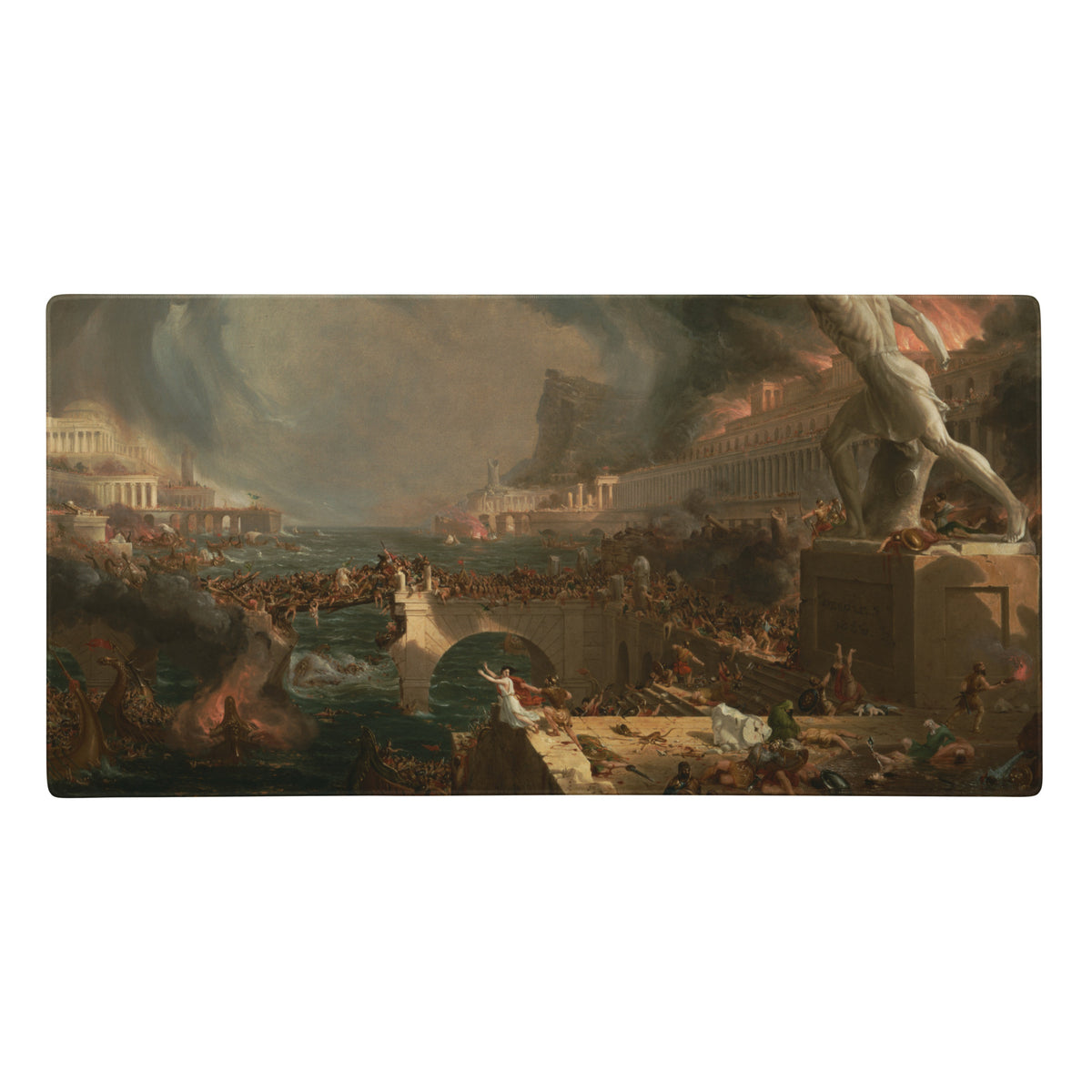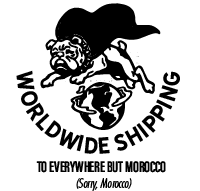












Destruction Thomas Cole The Course of Empire Desk Mat
The Course of Empire is a series of five paintings created by Thomas Cole in 1833 through 1836. It is notable in part for reflecting popular American sentiments of the times, when many saw pastoralism as the ideal phase of human civilization, fearing that empire would lead to gluttony and inevitable decay. The theme of cycles is one that Cole returned to frequently, such as in his The Voyage of Life series. The Course of Empire comprises the following works: The Course of Empire – The Savage State; The Arcadian or Pastoral State; The Consummation of Empire; Destruction; and Desolation. The original works were quite large, with all the canvases 39.5 inches by 63.5 inches (100 cm by 161 cm) except The Consummation of Empire which is even larger at 51″ by 76″ (130 cm by 193 cm). We've reproduced them as beautiful giclée prints in a much more manageable 18" x 11" and 36" x 24".
The fourth painting, Destruction, has almost the same perspective as the third, though the artist has stepped back a bit to allow a wider scene of the action, and moved almost to the center of the river. The action is the sack and destruction of the city, in the course of a tempest seen in the distance. It seems that a fleet of enemy warriors has overthrown the city's defenses, sailed up the river, and is busy ransacking the city and killing its inhabitants and raping women. The bridge across which the triumphant procession had crossed is broken; a makeshift crossing strains under the weight of soldiers and refugees. Columns are broken, and fire breaks from the upper floors of a palace on the river bank.
In the foreground a statue of some venerable hero (posed like the Borghese Gladiator) stands headless, still striding forward into the uncertain future.[a] In the waning light of late afternoon, the dead lie where they fell, in fountains and atop the monuments built to celebrate the affluence of the now fallen civilization. The scene is perhaps suggested by the Vandal sack of Rome in 455. On the other hand, a detail in the lower right of "The Consummation of Empire" shows two children, maybe brothers, fighting, one clad in red and the other in green—the colors of banners of the two contending forces in "Destruction," which thus might depict a foreshadowed civil war.
The children, now men, are shown, with one having finally prevailed over the other but seemingly in contemplation of the heavy price paid. In the painting, the red and green banners are on different sides of the river, with the green banners mostly on the temple side and the red banners predominantly on the palace side, maybe showing the still ongoing war between traditionalism and modernism
COLE'S DESCRIPTION:
No. 4.— The picture represents the Vicious State, or State of Destruction. Ages may have passed since the scene of glory — though the decline of nations is generally more rapid than their rise. Luxury has weakened and debased. A savage enemy has entered the city. A fierce tempest is raging. Walls and colonnades have been thrown down. Temples and palaces are burning. An arch of the bridge, over which the triumphal procession was passing in the former scene, has been battered down, and the broken pillars, and ruins of war engines, and the temporary bridge that has been thrown over, indicate that this has been the scene of fierce contention. Now there is a mingled multitude battling on the narrow bridge, whose insecurity makes the conflict doubly fearful. Horses and men are precipitated into the foaming waters beneath; war galleys are contending: one vessel is in flames, and another is sinking beneath the prow of a superior foe. In the more distant part of the harbor, the contending vessels are dashed by the furious waves, and some are burning. Along the battlements, among the ruined Caryatides, the contention is fierce; and the combatants fight amid the smoke and flame of prostrate edifices. In the fore-ground are several dead and dying; some bodies have fallen in the basin of a fountain, tinging the waters with their blood. A female is seen sitting in mute despair over the dead body of her son, and a young woman is escaping from the ruffian grasp of a soldier, by leaping over the battlement; another soldier drags a woman by the hair down the steps that form part of the pedestal of a mutilated colossal statue, whose shattered head lies on the pavement below. A barbarous and destroying enemy conquers and sacks the city. Description of this picture is perhaps needless; carnage and destruction are its elements.
With its large size and quality edge stitching, this gaming mouse pad turns your gaming setup into a professional gaming station ready for Dota, CSGO, and more. Don’t worry about jerky mouse movements ever again, as the underlayer features a reliable non-slip surface that keeps the entire mat firmly rooted to your table.
• 100% polyester
• Rubber non-slip base
• Sizes: 36″ × 18″ (91.4 cm × 45.7 cm), 18″ × 16″ (45.8 cm × 40.7 cm)
• Vibrant prints, long lasting
• High-quality edge stitching that doesn’t peel
• Non-slip surface
• Rounded edges
• Blank product sourced from Taiwan and printed in the USA
Size guide
| WIDTH (inches) | HEIGHT (inches) | THICKNESS (inches) | |
| 18″×16″ | 16 | 18 | ⅛ |
| 36″×18″ | 18 | 36 | ⅛ |
| WIDTH (cm) | HEIGHT (cm) | THICKNESS (cm) | |
| 18″×16″ | 40.6 | 45.7 | 0.4 |
| 36″×18″ | 45.7 | 91.4 | 0.4 |
Collections: Desk Mats and Playmats, Father's Day, Handmade | Made by Hand by Maniacs, Home, Mouse Pads, Tech Accessories
Type: Mouse Pad
Category: 19th century, 4th turning, allegorical, art, art print, civilization, classical paintings, crisis, cycle, desk mat, destruction, gaming, landscape, liberty maniacs, mouse pad, oil painting, painting, playmat, poster, posters, The Course of Empire, Thomas Cole, wall art, western civilization




















